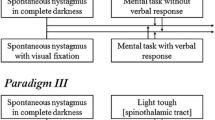Abstract
Caloric vestibular stimulation (CVS) and galvanic vestibular stimulation (GVS) act primarily on the peripheral vestibular system. Although the electrical current applied during GVS is thought to flow through peripheral vestibular organs, some current may spread into areas within the central nervous system, particularly when the bilateral galvanic vestibular stimulation (bGVS) method is used. According to Alexander’s law, the magnitude of nystagmus increases with eccentric gaze movement, due to the function of the neural integrator (NI); thus, if the information for vestibular stimulation corresponds to Alexander’s law, the peripheral vestibular organ is stimulated. Therefore, it would appear that if CVS results comply with Alexander’s law, and bGVS results do not, the sites stimulated by bGVS are not perfectly located in the peripheral vestibular area. In our experiments on normal human subjects, the magnitude of nystagmus under CVS increased with rising gaze eccentricity in the direction that the magnitude of the nystagmus increases, and this change was found to follow Alexander’s law. However, in the case of nystagmus under bGVS, results did not follow Alexander’s law. In addition, study of the influences of bGVS at different current intensities on nystagmus magnitude showed that bGVS at 5 mA distorted nystagmus magnitude more than at 3 mA, which suggests bGVS acts not only on the peripheral vestibular nerves, but also on some areas of the central nervous system, particularly the NI. According to our experiments, bGVS directly affects neural integrator function.



Similar content being viewed by others
References
Anagnostou E, Heimberger J, Sklavos S, Anastasopoulos D (2011) Alexander’s law during high-acceleration head rotations in humans. NeuroReport 22(5):239–243
Aw ST, Todd MJ, Aw GE, Weber KP, Halmagyi GM (2008) Gentamicin vestibulotoxicity impairs human electrically evoked vestibulo-ocular reflex. Neurology 71:1776–1782
Baird RA, Desmadryl G, Fernandez C, Goldberg JM (1988) The vestibular nerve of the chinchilla. II. Relation between afferent response properties and peripheral innervation patterns in the semicircular canals. J Neurophysiol 60(1):182–203
Bockisch CJ, Khojasteh E, Straumann D, Hegemann SCA (2012) Development of eye position dependency of slow phase velocity during caloric stimulation. PLoS One 7(12):e51409. doi:10.1371/journal.pone.0051409
Cannon SC, Robinson DA (1987) Loss of the neural integrator of the oculomotor system from brain stem lesions in monkey. J Neurophysiol 57:1383–1409
Cauquil AS, Bousquet P, Costes Salon MC, Dupui P, Bessou P (1997) Monaural and binaural galvanic vestibular stimulation in human dynamic balance function. Gait Posture 6:210–217
Crawford JD, Cadera W, Vilis T (1991) Generation of torsional and vertical eye position signals by the interstitial nucleus of cajal. Science 252:1551–1553
Dera T (2009) Displacement of Listing’s plane by galvanic vestibular stimulation measured by 3-dimensional video-oculography. Ann N Y Acad Sci 1164:347–349
Doslak MJ, Dell’Osso LF, Daroff RB (1982) Alexander’s law: a model and resulting study. Ann Otol Rhinol Laryngol 91(3):316–322
Ferdjallah M, Bostick FX Jr, Barr RE (1996) Potential and current density distributions of cranial electrotherapy stimulation (CES) in a four-concentric-spheres model. IEEE Trans Biomed Eng 43:939–943
Goldberg JM, Smith CE, Fernandez C (1984) Relation between discharge regularity and responses to externally applied galvanic currents in vestibular nerve afferents of the squirrel monkey. J Neurophysiol 51(6):1236–1256
Goldberg JM, Brichta AM, Wackym PA (2000) Efferent vestibular system: anatomy, physiology and neurochemistry. Neurochemistry of the vestibular system. CRC Press, Boca Raton, pp 61–94
Hong KH, Lim YG, Park KS (2009) Effectiveness of thigh-to-thigh current path for the measurement of abdominal fat in bioelectrical impedance analysis. Med Biol Eng Comput 47:1265–1271
Hong KH, Shim H, Kim S, Park E, Kim K, Lee SM (2013) Galvanic vestibular stimulation with Alexander’s law: preliminary study. In: 6th International IEEE/EMBS conference neural engineering
Khojasteh E, Bockisch CJ, Straumann D, Hegemann SCA (2013) A dynamic model for eye-position-dependence of spontaneous nystagmus in acute unilateral vestibular deficit (Alexander’s law). Eur J Neurosci 37:141–149
Kim J (2013) Tonic eye movements induced by bilateral and unilateral galvanic vestibular stimulation (GVS) in guinea pigs. Brain Res Bull 90:72–78
Lobel E, Kleine JF, Leroy-Willig A, Van de Moortele PF, Le Bihan D, Grusser OJ, Berthoz A (1999) Cortical areas activated by bilateral galvanic vestibular stimulation. Ann N Y Acad Sci 871(1):313–323
MacDougall HG, Brizuela AE, Curthoys IS (2003) Linearity, symmetry and additivity of the human eye-movement response to maintained unilateral and bilateral surface galvanic (DC) vestibular stimulation. Exp Brain Res 148:166–175
Mettens P, Godaux E, Cheron G, Galiana HL (1994) Effect of muscimol microinjections into the prepositus hypoglossai and the medial vestibular nuclei on cat eye movements. J Neurophysiol 72(2):785–802
Miranda PC, Lomarev M, Hallett M (2006) Modeling the current distribution during transcranial direct current stimulation. Clin Neurophysiol 117(7):1623–1629
Robinson DA (1981) The use of control systems analysis in the neurophysiology of eye movements. Ann Rev Neurosci 4:463–503
Robinson DA, Zee DS, Hain TC, Holmes A, Rosenberg LF (1984) Alexander’s law: its behavior and origin in the human vestibulo-ocular reflex. Ann Neurol 16(6):714–722
Rush S, Driscoll DA (1968) Current distribution in the brain from surface electrodes. Anesth Analg 47:717–723
Scudder CA, Kaneko CS, Fuchs AF (2002) The brainstem burst generator for saccadic eye movements: a modern synthesis. Exp Brain Res 142:439–462
Tehovnik EJ (1996) Electrical stimulation of neural tissue to evoke behavioral responses. J Neurosci Methods 65:1–17
Utz KS, Dimova V, Oppenländer K, Kerkhoff G (2010) Electrified minds: transcranial direct current stimulation (tDCS) and galvanic vestibular stimulation (GVS) as methods of non-invasive brain stimulation in neuropsychology—a review of current data and future implications. Neuropsychologia 48:2789–2810
Wardman DL, Fitzpatrick RC (2002) What does galvanic vestibular stimulation stimulate? Adv Exp Med Biol 508:119–128
Acknowledgments
This research was supported by the Basic Science Research Program through the National Research Foundation of Korea (NRF) funded in part by the Ministry of Education (#2010-0020163) and in part by the Ministry of Science, ICT and Future Planning (#NRF-2013R1A2A2A04014796).
Author information
Authors and Affiliations
Corresponding author
Rights and permissions
About this article
Cite this article
Hong, K., Shim, Hm., Goh, M. et al. Direct perturbation of neural integrator by bilateral galvanic vestibular stimulation. Med Biol Eng Comput 55, 207–212 (2017). https://doi.org/10.1007/s11517-016-1502-0
Received:
Accepted:
Published:
Issue Date:
DOI: https://doi.org/10.1007/s11517-016-1502-0




